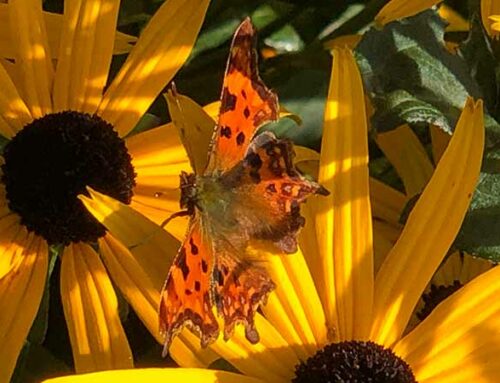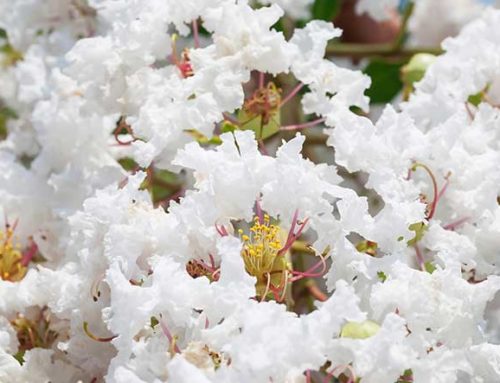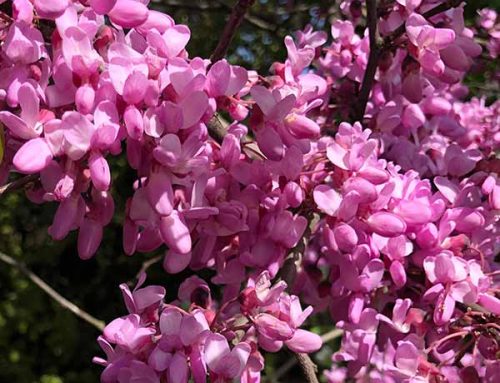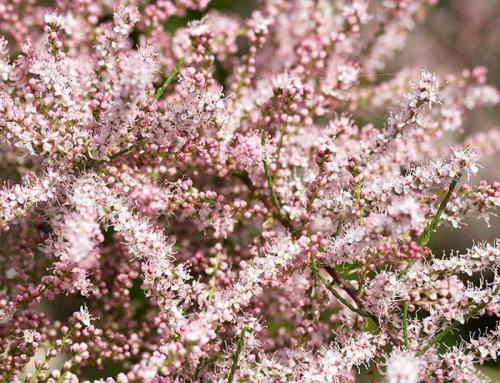The genus Philadelphus is comprised of about 65 plants. The native habitat of Philadelphus Mock Orange stretches across North America, parts of Europe, Northern Asia, and Japan. The plant’s historic nostalgia has been forever written into the lore of the American West by the famous Lewis and Clark Expedition. The explorer Meriwether Lewis gathered samples of the intoxicatingly fragrant bush during the return leg of his journey through Idaho and Montana in 1806. The plants he gathered were dubbed the Philadelphus lewissi in his honour.
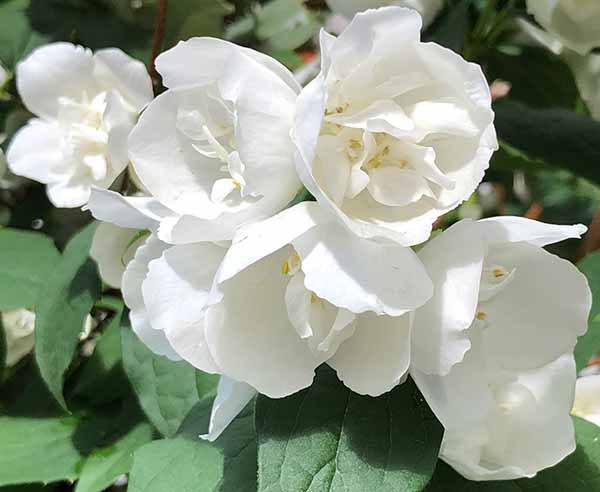
Phildelphus Virginal flowering in early Summer
Philadelphus Mock Orange shrubs vary in size and some leaf structure. However, these showy plants all have one thing in common — they all produce an abundance of eye-catching white or yellow petaled flowers with bright yellow stamens that possess a heady aroma.
Carl Linnaeus, the Swedish botanist, physician, and zoologist, chose to call the plant genus ‘Philadelphus’, a word that loosely translates as ‘extreme’, because of the strong, intoxicating fragrance of the flowers of this deciduous shrub. One flower can easily fill an entire room with its sweet perfume. Many refer to the Philadelphus shrubs as ‘Mock Oranges’ because the flower’s scent is similar to that of an orange tree in full bloom but more pronounced and a bit sweeter. The shrub’s blossoms draw an abundance of butterflies and bees to the garden. In the morning and early evening hours, one shrub can fill the entire garden with its sweet, relaxing scent.
Which Philadelphus Mock Orange — Helping you Choose
Our Philadelphus Mock Orange collection currently comprises six varieties that are especially suited to the UK’s climate, all of which are available to buy online. Our Philadelphus shrubs vary in size and growth habit to suit a wide range of gardening needs. From climbers to dwarfs to standard shrubs — we have chosen the optimum Philadelphus Mock Orange varieties to offer to our clients.

Philadelphus Coronarius flower
Philadelphus Manteau d’Hermine
The petite Philadelphus Manteau d’Hermine is a dwarf and only grows to a height of 60 to 80 centimeters with a spreading habit of 1 to 1.5 metres. However, don’t let the shrub’s diminutive size fool you because it produces an abundance of double blossoms. Its compact form rarely requires pruning to stay neat and tidy. The virtually carefree shrub grows throughout Britain and Ireland. It even thrives in coastal regions. It was awarded the esteemed Award of Garden Merit of the Royal Horticultural Society.
Philadelphus Virginal
If you are seeking a statuesque climber then look no further than the Philadelphus Virginal. It grows to a height of 1.75 metres and can easily traverse walls, fences, trellises, arbors, and pergolas. During the months of June and July, the climber bursts forth with a profusion of double white flowers. The blossoms appear not only at the end of the climber’s stems but also along the stem’s entire length. Exceptionally hardy, the Philadelphus Virginal grows throughout the UK. It tolerates coastal regions and salt. It clings well, even in high winds.
Philadelphus Schneesturm
The showy Philadelphus Schneesturm is a German variety of the above-mentioned Philadelphus Virginal. In case you are looking for a highly decorative flowering shrub to be grown as a specimen, this cultivar is ideally suited for that role. With its maximum height and spread of 2.5 metres, Philadelphus Snow Storm is a match for both spacious and small gardens. This attractive shrub is loved for its profusion of heady pure white flowers that bloom from June through to July and good autumn colour. The arching stems look positively regal when the leaves turn to a hue of molten gold!
Philadelphus Lemoinei
The Philadelphus Lemoinei is highly coveted by gardeners for its exceptionally strong fragrance. It was first developed in France in the 1880s and rapidly gained favour with gardeners in the UK. In May and June, it produces a profusion of single white flowers with highly noticeable yellow stamens that appear in dazzling groups of three and five. Each flower measures about 2 ½ centimeters across. The fragrant clusters of blossoms persist on the shrub into July and August. The shrub grows to a height of 2.5 metres but it tolerates pruning well so its size can be maintained smaller. It also grows well in a container.
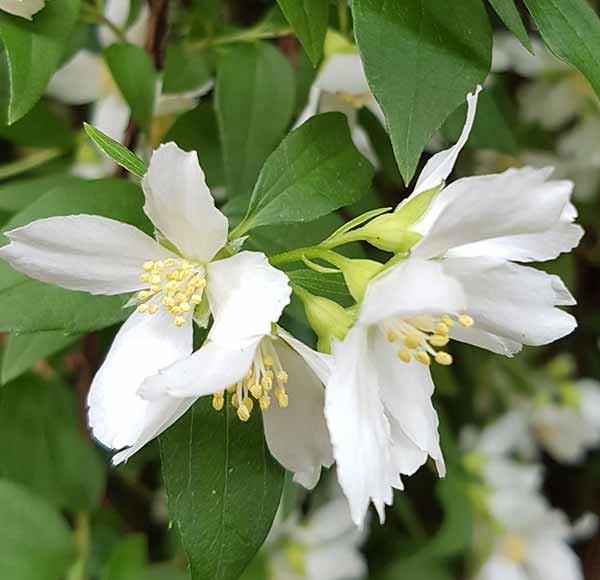
Philadelphus Lemonei flowering
Philadelphus Coronarius Aureus
The spring foliage of the Philadelphus Coronarius Aureus emerges a bright yellow and then fades to a chartreuse green when mature. During the early summer months, it offers up a display of abundant white flowers that many says have a slight lemon fragrance. It grows to a height to 1 ½ metres but can be pruned to a smaller size. The Philadelphus Coronarius Aureus grows well in partial shade which makes the hardy shrub an excellent choice for a woodland garden. It grows well in areas up to a zone H-6 hardiness. Its toughness makes it well suited to coastal regions.
Philadelphus Belle Etoile
The Philadelphus Belle Etoile erupts in a profusion of white flowers that measure 5 centimeters across. The flowers feature orange tinged petals with stamens that are encircled with just a hint of lilac shading. It has an arching growth habit and will attain a height of 1 ½ metres. Its width averages 2 ½ meters when fully grown. A hardy shrub, it will grow in a wide range of soil conditions where other shrubs might fail. It withstands sandy, chalky, clay, and loamy soil types. The sturdy shrub is also not picky about pH balance. The Belle Etoile was bestowed the honour of the Award of Garden Merit by the Royal Horticultural Society.
Philadelphus Coronarius
The Philadelphus Coronarius is frequently referred to as the ‘Common Mock Orange.’ The shrub is hardy throughout the UK. Its foliage emerges a golden shade in the spring and fades to a light green upon maturity. In the early summer, the shrub bursts out in a cascade of white blossoms that measure 2 ½ centimeters across and boast a yellow center. The flowers are highly fragrant. It grows well in full sun or partial shade. Once established it features exceptional drought hardiness. The robust shrub grows in urban conditions and in coastal regions. When fully grown it reaches a height of 1.25 metres. Plant this hardy shrub near a window or patio where its heady fragrance can be enjoyed. The flowers can also be cut and brought indoors to create a fragrant, long-lasting bouquet.
Anyone seeking an exceptionally hardy, carefree deciduous shrub or climber that produces abundant fragrant flowers will fall in love with Philadelphus Mock Orange. A true garden performer, they can be used as an informal hedge, border plant, cottage garden specimen, privacy screen, or anywhere you want to add a splash of colour mixed with a heavenly ambrosia of scents that are sure to titillate the senses.

